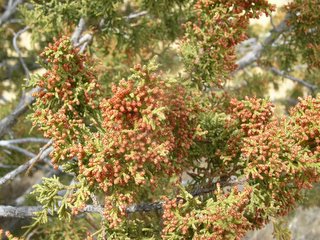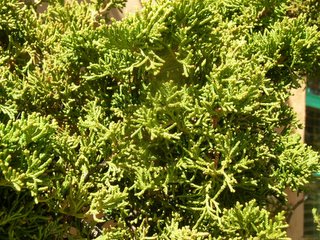 NE OF CABEZON PEAK--This area near the new Ojito Wilderness is basically barren of trees. What trees there are, however, are junipers...and right now they are just loaded with pollen. Anytime you see a brown juniper you are looking at pollen. The slightest breeze wafts clouds of it into the air. If you hit a branch with your hand, the clouds are plainly visible.
NE OF CABEZON PEAK--This area near the new Ojito Wilderness is basically barren of trees. What trees there are, however, are junipers...and right now they are just loaded with pollen. Anytime you see a brown juniper you are looking at pollen. The slightest breeze wafts clouds of it into the air. If you hit a branch with your hand, the clouds are plainly visible.John Fleck and Sophie Martin are looking at this from a global warming perspective. I imagine they are correct. But I do know that certain areas around here are extremely heavy with this pollen at certain times of the year. I would recommend staying away from t
 his area SE of San Ysidro on the Cabezon road. From experience in previous years I would suspect that the road that goes around Ladron Peak to Magdalena is also full of pollen-bearing trees. That last road might even be dangerous for those with severe juniper allergies until things settle down.
his area SE of San Ysidro on the Cabezon road. From experience in previous years I would suspect that the road that goes around Ladron Peak to Magdalena is also full of pollen-bearing trees. That last road might even be dangerous for those with severe juniper allergies until things settle down.Around my neighborhood in Nob Hill, the junipers are not yet emitting pollen. Down the street on one of those "bushy type" junipers (in picture above), there are a lot of berries but no pollen at this point.
In my own front yard are a couple of the "pole" type junipers co
 mmonly called cedars, although they are actually a type of juniper. It is also free from pollen. This tree has a lot of pollen in the spring, but right now...everything is quiet.
mmonly called cedars, although they are actually a type of juniper. It is also free from pollen. This tree has a lot of pollen in the spring, but right now...everything is quiet.One of the commenters on Fleck's post talks about urban landscaping being part of the problem. It is...but I have a feeling that the allergy situation is also largely due to the native junipers which dot the wildlands.
1 comment:
John Fleck says -
One of the questions I've had (wait, isn't it my job to find answers to questions?) is what effect drought has on juniper pollen production. Do they produce more pollen in the drought (desperate to reproduce before they die?)? Or do they produce less, saving their energy for staying alive?
Post a Comment